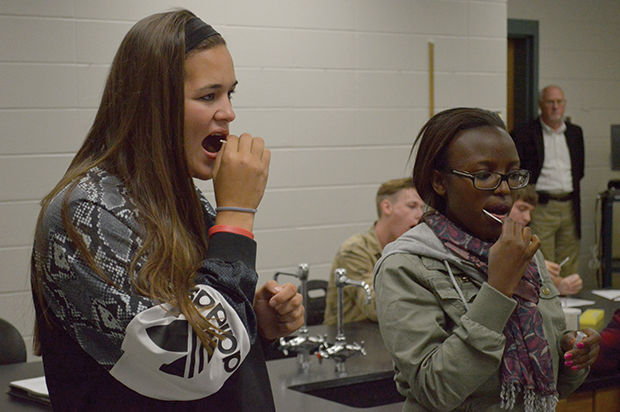DNA lab receives new state-of-the-art technology
Katie Skelton and Jane Nbugua, sophomore biology majors, swab the inside of their cheeks to obtain DNA samples to be analyzed by the biology department’s new qPCR thermocycler Nov. 9.
A new piece of equipment in the biology department will help put students working in the MSSU and Newman Innovation Center DNA Training and Research Lab at the forefront of technology and allow new possibilities for hands-on learning,
The new quantitative polymearse chain reaction (qPCR) thermocycler purchased by the University is designed to amplify and quantitate DNA sequences via a series of temperature changes. Results from this machine allow researchers to identify DNA sequences from viruses, bacteria, fungi, plants and animals.
During a lab session Nov. 9 in Reynolds Hall room 252, Scott Wells and Gerald Schlink instructed students how to use the new equipment for the purpose of identifying gender, having them collect their own DNA via mouth swabs first.
“This is a game-changer as far as DNA technology goes,” said Schlink of the new equipment. “Any student going into the health field is going to be directly impacted by this, any student going into the food industry is going to be impacted by this, any in conservation – when you want to go out and identify what animals did what, you can identify just by looking at it.”
Once the DNA is put through the qPCR thermocycler, the students were able to monitor the results by observing spikes in the real-time analysis that indicate the presence of a gene on the Y chromosome. If a Y chromosome is present, it means the sample is from a male.
“This machine, because of its new technology, it can heat and cool faster, so results are done in a half hour versus two to three hours [which is how long results used to take],” said Schlink.
In addition to faster analysis, the new machine allows students to access the results of any analysis from their smartphone or laptop by connecting to the cloud.
“We have an outdated machine [similar to the qPCR] that we used to use in the crime lab that is 15 years old and the results were more difficult to explain,” said Schlink. “This machine, the analysis is straightforward — you push a button and the analyses are done. So, with this machine, we can incorporate the technology at an earlier level in our curriculum.”
Your donation will support the student journalists of Missouri Southern State University. Your contribution will allow us to purchase equipment and cover our annual website hosting costs.




























